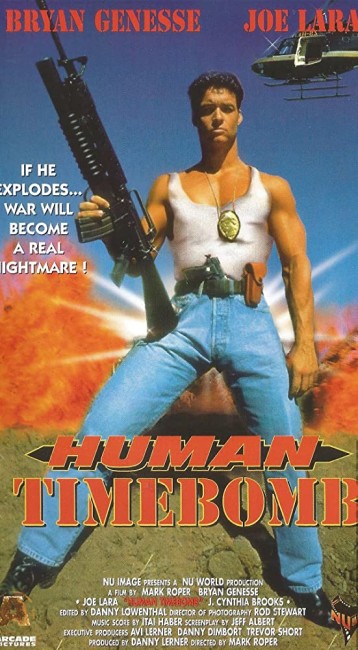aka Live Wire 2: Human Timebomb
Crew
Director – Mark Roper, Screenplay – Jeff Albert, Producer – Danny Lerner, Photography – Rod Stewart, Music – Itai Haber, Special Effects – Rick Creswell, Production Design – Raymond Wilson. Production Company’– Nu World.
Cast
Bryan Genesse (Parker), Joe Lara (Colonel Price), J. Cynthia Brooks (Gina Young), Anthony Fridjhon (General Raoul Arnaz), Frantz Dobrowsky (Pablo Arnaz), Gavin Hood (Mike Young)
Plot
FBI agent Parker arrests Cuban national Pablo Arnaz during a massive shootout as Pablo purchases a computer chip from a drug dealer in return for a large amount of cocaine. Later Parker discovers that the chip is a neural implant that can turn soldiers into perfect fighting machines. Parker then learns that Pablo is the nephew of Cuba’s General Raoul Arnaz and is to be traded back to Cuba in return for a captured American soldier. Parker insists on going along as part of the exchange. However, the mission goes wrong, during which Parker is captured by General Arnaz. He is then implanted with the chip, turning him into a mindless programmed soldier. He is now made part of the army with which General Arnaz, under the leadership of the American mercenary Colonel Price, is planning to lead a revolution to overthrow Fidel Castro.
Human Timebomb is an Action Film from the American production company Nu Image and their releasing arm Nu World. Since the early 1990s, Nu Image, formed by producer Avi Lerner, have been extremely prolific, making a great many low-budget action films – over 150 titles, including the odd genre entry or crossover. These have included the likes of Cyborg Cop (1993) and sequels, and a number of monster movies such as Shark Attack (1999) and sequels, Crocodile (2000), Spiders (2000), Octopus (2000), Shark Zone (2003), Larva (2005) and Mansquito (2005), among others.
Human Timebomb appears to have been made to capitalise on the success of Roland Emmerich’s Universal Soldier (1992), which came out two years earlier and featured the theme of mind-controlled soldiers. However, even as B-budget action films go, Human Timebomb is on the mindless side. It seems constructed solely for the purpose of showing off lots of explosions, martial arts battles and vehicular chases.
Certainly some of the fight scenes manage to be quite ferocious and the film has a massive body count but it is all meaninglessly spectacular in a B-budget way. Quite often some of the action scenes have nothing to do with the main drama of what is going on – a simple chase across an airfield for no particular reason has lots of explosions and vehicle stunts happening all over the place in the background.
Hero Bryan Genesse, a regular actor in Nu Image’s films, has a shrill voice and an attitude of self-righteous superiority that grates. What takes Human Timebomb from being merely mindless to the obnoxious is its often contemptuous attitude – some of Bryan Genesse’s comments regarding the Cubans are quite racist, which is something that the film seems to unquestioningly support. In the role of the American mercenary, Joe Lara is much better than Genesse, this type of dark villainous role suiting him far more so than the muscular hero roles he has usually been cast in.
In some versions of its release, Human Timebomb was retitled Live Wire 2: The Human Timebomb, posing as a sequel to Live Wire (1992). Live Wire concerned terrorists who were able to turn people into human bombs as opposed to programmed soldiers and, other than a more accurate (and indeed literal) usage of the phrase Human Timebomb, the two films have no connection in any way.
Mark Roper is a South African born director who has specialised in action films, starting with Orion’s Key/Project Shadowchaser 4/Alien Chaser (1996). He has made several other films for Nu Image, including Warhead (1996), City of Fear (2001), Marines (2003), their Nature Unleashed films and a couple of the Operation Delta Force sequels.


